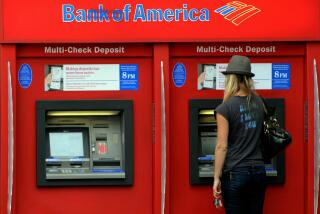Bank on Youth : More children are learning to save money, with financial institutions helping by offering no-fee accounts.
- Share via
A year ago, Ryan Jeffrey White was tired of spending all his money as soon as he earned it, so he decided to start a savings account and now has more than doubled his initial deposit. Ryan, 13, has $340.
He is one of a growing number of children who are learning to accumulate money the old-fashioned way--by saving. Many banks offer no-fee savings accounts for students, and several provide kid-friendly information booklets and even short courses on money management.
“I like having somewhere I can hold my money so I won’t spend it,” says Ryan, a Canoga Park resident. “It’s fun. It makes me feel more mature because a lot of other people go out and spend their money as fast as they make it.”
White does his banking at Wells Fargo, which offers a special program for children. The students get a personalized kit with an automatic teller machine card and personalized deposit and withdrawal forms. The accounts are set up to allow automatic deposit, too. Ryan’s mother, Kurtina Roberts, an accountant, plops Ryan’s $20 biweekly allowance straight into his account when she gets paid.
Ryan is responsible for reviewing his bank statement, checking the interest and making additional regular deposits as he earns money through baby-sitting and chores. Ryan’s sister, Amanda Roberts, 8, just opened her account, starting with a $50 bill she received as a Christmas gift. She’ll be getting automatic deposits of $5 a month allowance, also direct from her mother’s paycheck.
“I think having a savings account makes them a little more responsible,” Roberts says. “Do they go and clean their rooms? No. But when they’re given money, they think about it.”
That’s what Eileen Utter, product manager for Wells Fargo, says she had in mind when she started the program in November, 1991. “Saving is a learned behavior and someone needs to show you how to do it,” she says. More than 70,000 children have opened WF-1 accounts, she says, and the biggest concentration of those kids live in the Los Angeles area. Branch managers say the kids often come in on a weekly basis to deposit their earnings.
The bank also developed a lesson plan for employees to use when they teach classes about savings in school. “There’s a wide range of knowledge among students regarding banking,” Utter says. “Some are amazed at the concept of interest, and some are very sophisticated.”
The ideal time to begin children’s savings accounts, she says, is between the ages of 10 and 14, when they start enjoying their first influx of real cash. Children in this age range start to earn money for special chores--like mowing the lawn or baby-sitting--and may receive cash from friends and relatives who find guessing a preteen’s gift preference a real challenge, she says.
“Banking can be fun--really,” Utter says. “Everyone has a warm fuzzy feeling about the time they first went to a bank and started an account.”
Bank of America offers high school students an economics course at neighborhood locations throughout the San Fernando Valley. The students are taught the history of money, personal finance and how to get credit, how to qualify for a loan and how to balance a checking account.
Bernice Taylor-Sherman, a bank auditor who frequently teaches the classes, says she takes a poll at every class to see who among the students already has a savings or checking account. “Often, as many as 70% of the students have neither,” she says.
Taylor-Sherman says that based on her teaching experience, the students appear to know less about finances today than teen-agers did 20 years ago. “That probably has a lot to do with parenting. Many kids today don’t know where the money goes.”
Student Accounts
What some banks are offering children: Bank of America: If a child is less than 21 and a student, school savings accounts are free and require no minimum. Checking accounts for students are limited to 10 checks per month and a minimum balance of $100. There is unlimited automatic teller machine use. A pamphlet on “A Student’s Survival Guide to Checking, Savings, Credit and Other Useful Tools for Managing Your Money” is available at branches when students open new accounts. First Interstate Bank: The minimum balance fee is waived for children under 18 if the account is established as a trust account (with a parent co-signing when the account is set up). Glendale Federal: There is no service charge for a savings account if the student is under 18. Home Federal: There is no service change if the student is under 18, and no minimum balance is required. Some branches provide lessons on banking for schoolchildren. Wells Fargo: Children’s program, CLUB WF-1, includes no-fee savings and a free ATM card (but only one withdrawal a month is allowed to maintain the no-fee status). Personalized withdrawal and deposit slips and a savings account register are included at no charge. A 46-page booklet, “Checking Account Owners Guide: Practical Advice for Making the Most of Your Checking Account,” is also available at no charge.
More to Read
Inside the business of entertainment
The Wide Shot brings you news, analysis and insights on everything from streaming wars to production — and what it all means for the future.
You may occasionally receive promotional content from the Los Angeles Times.










